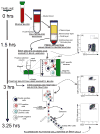Ex vivo purification and characterization of human invariant Natural Killer T cells
- PMID: 21854781
- PMCID: PMC4619040
- DOI: 10.1016/j.jim.2011.08.002
Ex vivo purification and characterization of human invariant Natural Killer T cells
Abstract
Natural Killer T (NKT) cells have gained widespread attention among immunologists because of their distinct ability to regulate anti-tumor responses and to influence the outcome of infections or autoimmunity. Type I (also called invariant) NKT cells (iNKT) are best characterized mainly because of the availability of lipid antigen-loaded CD1d-tetramer detection reagents. Human iNKT cells present important phenotypic differences relative to their murine counterpart, restricting the extrapolation of findings from experimental murine models to human health and disease states. Particularly, the ontogeny and early life phenotype of iNKT cells largely differ between human and mice, indicating divergent functional properties between species. The high therapeutic potential offered by manipulation of iNKT cells in disease warrants a better understanding of human iNKT cell biology. Here, we discuss characteristics of human iNKT cells and present an efficient and rapid method for their ex vivo purification and characterization.
Copyright © 2011 Elsevier B.V. All rights reserved.
Figures



Similar articles
-
Characterization and Functional Analysis of Mouse Semi-invariant Natural T Cells.Curr Protoc Immunol. 2017 Apr 3;117:14.13.1-14.13.55. doi: 10.1002/cpim.22. Curr Protoc Immunol. 2017. PMID: 28369682
-
Isolation and functional use of human NKT cells.Curr Protoc Immunol. 2010 Aug;Chapter 14:Unit 14.11. doi: 10.1002/0471142735.im1411s90. Curr Protoc Immunol. 2010. PMID: 20814940
-
Porcine Invariant Natural Killer T Cells: Functional Profiling and Dynamics in Steady State and Viral Infections.Front Immunol. 2019 Jun 18;10:1380. doi: 10.3389/fimmu.2019.01380. eCollection 2019. Front Immunol. 2019. PMID: 31316500 Free PMC article.
-
New Genetically Manipulated Mice Provide Insights Into the Development and Physiological Functions of Invariant Natural Killer T Cells.Front Immunol. 2018 Jun 14;9:1294. doi: 10.3389/fimmu.2018.01294. eCollection 2018. Front Immunol. 2018. PMID: 29963043 Free PMC article. Review.
-
Invariant NKT cells: regulation and function during viral infection.PLoS Pathog. 2012;8(8):e1002838. doi: 10.1371/journal.ppat.1002838. Epub 2012 Aug 16. PLoS Pathog. 2012. PMID: 22916008 Free PMC article. Review.
Cited by
-
Hepatocellular cancer-derived alpha fetoprotein uptake reduces CD1 molecules on monocyte-derived dendritic cells.Cell Immunol. 2019 Jan;335:59-67. doi: 10.1016/j.cellimm.2018.10.011. Epub 2018 Nov 1. Cell Immunol. 2019. PMID: 30392891 Free PMC article.
-
An Immunological Perspective on Neonatal Sepsis.Trends Mol Med. 2016 Apr;22(4):290-302. doi: 10.1016/j.molmed.2016.02.001. Epub 2016 Mar 15. Trends Mol Med. 2016. PMID: 26993220 Free PMC article. Review.
-
Type 2 innate lymphoid cells: friends or foes-role in airway allergic inflammation and asthma.J Allergy (Cairo). 2012;2012:130937. doi: 10.1155/2012/130937. Epub 2012 Nov 11. J Allergy (Cairo). 2012. PMID: 23209480 Free PMC article.
-
Subpopulations of natural killer-T-like cells before and after surgical treatment of laryngeal cancer.Cent Eur J Immunol. 2017;42(3):252-258. doi: 10.5114/ceji.2017.70967. Epub 2017 Oct 30. Cent Eur J Immunol. 2017. PMID: 29204089 Free PMC article.
References
-
- Baev DV, Peng XH, Song L, Barnhart JR, Crooks GM, Weinberg KI, Metelitsa LS. Distinct homeostatic requirements of CD4+ and CD4− subsets of Valpha24-invariant natural killer T cells in humans. Blood. 2004;104:4150–6. - PubMed
-
- Bendelac A, Killeen N, Littman DR, Schwartz RH. A subset of CD4+ thymocytes selected by MHC class I molecules. Science. 1994;263:1774–8. - PubMed
-
- Bendelac A, Lantz O, Quimby ME, Yewdell JW, Bennink JR, Brutkiewicz RR. CD1 recognition by mouse NK1+ T lymphocytes. Science. 1995;268:863–5. - PubMed
-
- Berzins SP, Smyth MJ, Baxter AG. Presumed guilty: natural killer T cell defects and human disease. Nat Rev Immunol. 2011;11:131–42. - PubMed
Publication types
MeSH terms
Grants and funding
LinkOut - more resources
Full Text Sources

